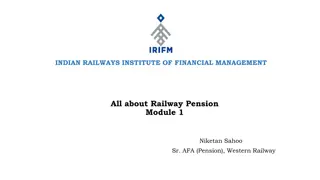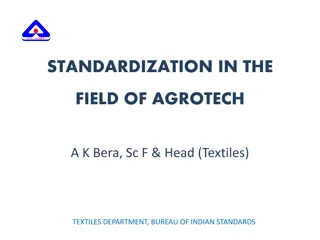Challenges and Opportunities for Indian Agriculture
Indian agriculture faces challenges such as low growth, sustainability issues, profitability constraints, climate change impacts, and inadequate infrastructure. However, there are opportunities like India being a global agricultural powerhouse with significant production in milk, pulses, spices, wheat, rice, and cotton, along with a large cattle herd. Addressing challenges and leveraging opportunities is crucial for the growth and sustainability of the agricultural sector in India.
Download Presentation

Please find below an Image/Link to download the presentation.
The content on the website is provided AS IS for your information and personal use only. It may not be sold, licensed, or shared on other websites without obtaining consent from the author. Download presentation by click this link. If you encounter any issues during the download, it is possible that the publisher has removed the file from their server.
E N D
Presentation Transcript
CHALLENGES AND OPPORTUNITIES FOR INDIAN AGRICULTURE Dr.B.Gangaiah Dr.B.Gangaiah Additional Director General Additional Director General Centre for Good Governance Centre for Good Governance 27.10.2014 27.10.2014 HICC Hyderabad HICC Hyderabad
INDIAN AGRICULTURE -MACRO DIMENSIONS Agricultural land 183.6 m.ha (2001-02 ) - 182.0 m.ha (2010-11) Arable land 157.35 m.ha (China-111.60 m.h) Share of agriculture & allied sectors 51.4% ( 1st Plan) to 15.2% ( 11thplan ) and 13.7% in 2012-13 Percentage of irrigated area 17.1% (1950-51) - 44.9% ( 2010-11). The cropping intensity 111.1 % (1950-51) - 140.5 % ( 2010-11). Average size of holding from 1.33 ha in 2000- 01 to 1.16 in 2010-11
INDIAN AGRICULTURE -MACRO DIMENSIONS No.operational holdings 129 million( 2005-06) to 138 million in 2010-11(Ag.Cen 2011) Total Investment in agriculture as percent of Agr.GDP has increased from 6.9% in first plan to 18.86% in 11thplan.(2004-5 prices) Public investment declined from 4.9% in 6th plan to 3.5% in 11thplan, Private investment has increased from 5.2% in 6thplan to 15.1% in 11thplan Rural Population 68.8 % of total population
CHALLENGES 1.Low growth- Weather Dependent,45% irrigation 2.Sustainability- land & environmental degradation unsustainable use of water, soils 3. Profitability- Size of farm- 1.33 to 1.16 Level of technology adoption Profitability of Agriculture vis-a-vis other sectors Raising small holder productivity Disguised unemployment-pressure on land
CHALLENGES 4.Sustaining investment- Neglect in policy- Decline in Public Investment(4.9 to 3.5 %) Low return- lack of Private interest 5.Climate change Droughts, floods, erratic rains - greatest impact in rain-fed areas India's crop yields could fall by 30% by 2050(IPCC) 6.Marketing- Price instability, Imperfect markets
CHALLENGES 7.Rising wages and other input costs- MNREGA, migration, energy 8.International Competitiveness-WTO 9.Inadequate infrastructure-Physical Supply chain constraints 10.Inadequacy of intuitions- credit and market, extension, R&D, risk management 11.Need for Large investments in Agro- processing
OPPORTUNITIES 1.India is a global agricultural powerhouse world s largest producer of milk, pulses, and spices, largest area under wheat, rice and cotton world s largest cattle herd (buffaloes) Second largest producer of rice, wheat, cotton, sugarcane, farmed fish, sheep & goat meat, fruit, vegetables and tea. 2.Diverse agro-climatic conditions/zones 4.Fertile soils 3.Large Domestic Market- Rising demand for food- high value fruits and proteins meat, dairy and fishery products. Rapid Urbanisation and increasing middle class 5.Domestic R&D and Extension capacity 6.Global Markets- expanding demand, bio-fuel competition
OPPORTUNITIES 7.Enterprising Farming Community 8.Scope for Increasing cropping intensity 9.Yeild Gap between world Average and across regions in India Best Farmers overall profitability is 77% higher than average farmers profitability Enhanced and balanced use of Fertilisers, HYV,irrigation can boost yields Better seeds can raise yields by 40% 10.Irrigation- minor irrigation has better returns on investment 11.Credit-larger credit availability for small farms can raise per capita output 12.Farm size-technology adoption, diversification
FOCUS AREAS FOR POLICY 1.Strategise for second green Revolution- dryland and Wasteland Development focus Efficiency in water use- more crop per drop Increased Irrigation- minor irrigation, precision farming Horticulture focus-NHM Investment in Promotion of soil Health 2.Focus on Animal Husbandry and Fisheries- Dairying, Aquaculture 3.Smart investments in post harvest and marketing infrastructure Supply Chain- Storage, processing, cold chain development Food Processing and Value addition activities Grading and Standardisation of Produce Commodity exchanges/Futures Markets Warehousing infrastructure
FOCUS AREAS FOR POLICY 4.Risk management measures-production and market risks 5.Reform Food Laws bring in Integrated Food Law- Essential Commodities Act, APMC Act, Forward Contracts (Regulation) Act 6.Demand Driven agriculture research and extension 7.Organic Farming 8.Technology- precision farming techniques, input use efficiency, processing and storage, marketing, 9.Crop Diversification- Shift from Rice-wheat cropping systems 10.Facilitating agricultural diversification to higher- value commodities
FOCUS AREAS FOR POLICY Marketing Reforms- APMC, creation of competitive markets, Development of National Market Modernisation of Seed Farming- Seed Laws etc Rural infrastructure development Agro-based food processing Promoting high growth commodities-Diary, Livestock, fishery Reduction in wastage on farm/off farm Credit Markets-reliance on private credit still large Risk insurance-market risk, production risk S&T-GM , precision Farming, protected farming, IT tools application
FOCUS AREAS FOR POLICY Institutional Innovations-Group Farming, Producer Companies, Contract Farming Liberalization of constraints to marketing, transport, export and processing Building competitive value chains from producers to urban centers and export markets National Policy for Farmers 2007 National Policy for Farmers 2007
CONCLUSIONS Address five Deficits of (a) investment, credit, infrastructure investment, credit, infrastructure (b) research, extension (technology) (b) research, extension (technology) (c) Market (c) Market (d) diversification (d) diversification (e) institutions (e) institutions (f) education/skill (f) education/skill
Thank You for Attention

 undefined
undefined




























